さいとうなおきさんも参戦! 絵が超絶レベルアップする色テクニックを大公開
明るい気持ちになる色、涼やかな気分になる色、深く落ち着いた心持ちになる色──そう聞いて、みなさんはどんな色を想像しましたか? 時に色は心を表し、また心も色による影響を大きく受けています。
イラストを描く時に、相手の心に響く色使いができたらすごく嬉しいですよね。でも、何度塗ってもしっくりこない時はありませんか? その違和感の原因が「色の使い方」だとしたら……?

ライター / 小川陽平 編集・撮影 / 佐久間仁美
カラーイラストはたくさんの色数を使う上、その組み合わせも無限大(!)。何をどう合わせたらよいのか、悩んでしまう人も多そうです。
今回はそんな色の使い方に悩む3人のお絵描き好きの困ったを解消すべく、特別講義を開催! マンガや小説の挿画、キャラクターデザインなど幅広いジャンルで活躍されているイラストレーター・さいとうなおきさんと、公益社団法人 色彩検定協会 認定色彩講師の石井文子さんを講師にお迎えし、悩みにズバッと答えていただきました。
きっとアナタの悩みも解決するヒントが見つかりますよ!
まずは課題にチャレンジ!

▲ 課題の線画。さいとうなおきさんの描き下ろしです!
今回の特別講義に参加してくれたのは、原田さん、四片さん、森田さんの3人。みなさん普段から趣味でイラストを描いていますが「カラーイラストで、もうワンランク上を目指したいけど、具体的にどうしたらよいのか分からない」という共通の悩みを抱えています。そんな3人には、事前に「線画に彩色する」という課題をこなしてもらいました。
まず、自力で仕上げてきた作品はこちら!

▲ 左から、森田さん・四片さん・原田さんの作品。
それぞれ思い思いに塗り仕上げてきた力作、どの作品も今のままで十分魅力的ですが……?
お絵描き歴は約2年の森田さんの作品
森田:
かわいらしくて夏らしいイラストですが、ちょっと儚げな印象を受けたんです。アクティブでない女の子が外出して……みたいなイメージで。まずは肌から塗りはじめて、その次に目や顔の周りへと塗り進めて完成までもっていきました。

さいとう:
明度、色相、彩度(※)、3つの要素がちゃんと整っていて、かつ一番大切な明度の設計がしっかりしてるのが素晴らしいです。目と帽子にちゃんと目がいくのがその証拠ですね。
石井:
そうですね、整ったバランスの良さを活かす方法をちゃんと学ぶと、すごいことになりそう。伸びしろを感じます。
(色彩検定公式テキスト 3級編 35ページより引用)
プロのアドバイス
バランスの良さが光る森田さんのイラスト、その理由は「ベースカラー」「アソートカラー」「アクセントカラー」の3つがきちんとしたバランスで用いられているから。
さいとうさんがオススメするバランスは、下記の通りです。
3種のカラー
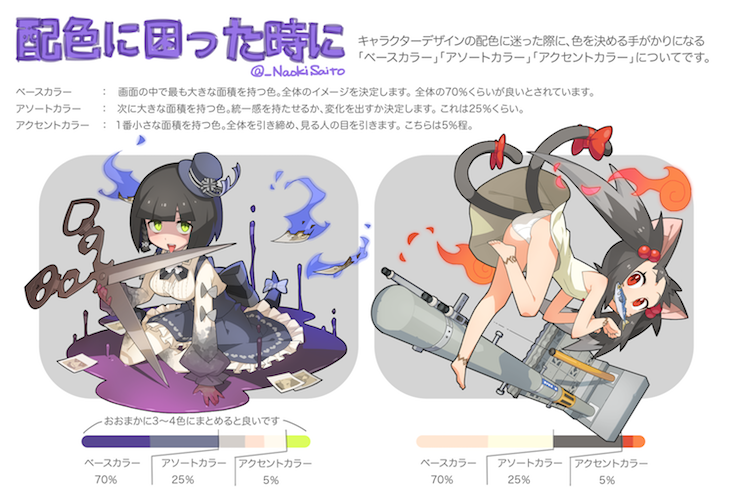
・ベースカラー
画面の中で最も大きな面積を持つ色で、全体のイメージを決定する。全体の70%くらいが良いとされています。
・アソートカラー
次に大きな面積を持つ色。統一感を持たせるか、変化を出すか決定します。これは全体の25%くらい。
・アクセントカラー
1番小さな面積を持つ色。全体を引き締め、見る人の目を引きます。こちらは全体の5%程度。

▲ 下のバーは、森田さんのイラストを「ベースカラー」「アソートカラー」「アクセントカラー」に分類したもの。
全体のイメージを決めるベースカラー(肌や帽子、花びらなど)、変化を生むアソートカラー(髪の毛、瞳、葉っぱなど)、注意を引き全体を締めるアクセントカラー(リボン)が理想的な割合で用いられることがわかります。見ていて心地がよい理由はこのバランスだったんですね。
その上で、さらに魅力的に見せるための提案とアドバイスが2つ提示されました。
赤は一番目を引く色
アクセントカラーの役割を果たしている赤いリボン。でも、一番見せたいのは女の子の顔なので、リボンではなく瞳にアクセントカラーを用いるようにしてみては?

ただ、瞳が赤いのは特殊能力っぽく見えるので、リボンの色を少し落として目を明るくしハイライトを入れる──これだけで印象がずっと変わります。


▲ 目のハイライトの周りを囲むように、アクセントカラーの赤をプラス。このテクニックは真似したくなりますね……!
補色の関係を覚えよう!
青い髪がしっかり前に出てきているのは、ヒマワリの黄色と青が「補色」の関係だから。青は周りの色で印象が大きく変わってくる難しい色ですが、このイラストではしっかり前に出てきています。素晴らしい! これが補色の効果です。
今回の色は感覚で選んだとのことですが、しっくりくる・こないの選択基準は究極的には感覚で、それができているのがとにかく素晴らしい。でも、知識があると、“しっくりこない絵”でも“しっくりくる絵”に近づけることができます。これから必ずやってくる“困ったとき”に知識があると、捨てる絵が確実に減らせますよ。
補色とは?

色相環において、もっとも離れた位置にある色同士の組み合わせを指します。図における赤と青緑、黄色と青紫といった、反対のイメージを持った色の組み合わせは、互いの色を際立たせるのに有効です。
(色彩検定公式テキスト 3級編 31ページより一部引用)
華やかな色使いが目を引く、四片さんの作品
四片:
とにかく目がかわいくて、大きなヒマワリが印象的でした。花は特に好きなモチーフなので、どんな風に塗ろうかを考えるのが楽しくて、ヒマワリの色ありきで全体のイメージを決めて仕上げました。

石井:
色相が豊かで、明るく鮮やかなトーンから、描き手のしっかりとした意志を感じます。見せ場である腕は艶やかに仕上げられ、とてもよく描けています。たくさんの色を使いつつも明度差は(あえて)小さく仕上げられ、女性が好む要素が詰まった作品に仕上がっていますね。
さいとう:
絵から元気があふれだしていますね! 「元気なテイストでいこう」という意図をしっかり感じます。意図と結果を結びつけられる人はあまりいないので、ぜひ自信を持ってください。たくさんの色を使っても破綻していないバランス感覚には脱帽です。僕はここで緑の服を選べない。でも、緑の服だからこそ(この作品は)印象的になりますね。
プロのアドバイス
元気なイメージがまっすぐに伝わってくる四片さんの作品。たくさんの色を使いつつも破綻せずにまとめ上げている力量に、さいとうさんと石井さんは感心しきり。だからこそ、その元気さをもっと際立たせるために必要なポイントがあるとのこと。
明度を細かく変えてみる
このイラストではヒマワリは全て同じ明度で描かれているので、例えば視線を集めたい中央の大きい花の明度差は大きく、帽子の小さな二つ(特に種ができる中央の筒状花(とうじょうか)の部分)は明度差を小さくしてみる。葉やリボンについても同様に検討して細かく調整すると、もっと見せたいところが明確になるはずです。
効果的に鮮やかに見せるためには
強調したいところ、鮮やかに見せたいところはどうしても明るく派手にしたくなるのが心情というもの。でも、派手にするとケバケバしく見える可能性も大きくなってしまいます。元気とケバいのは紙一重。鮮やかに見せたいのであれば、そのものを明るくする前に他の箇所を落とすのも試してみましょう。
しっとりと塗りあげた原田さんの作品
原田:
線画を見て、かわいらしく明るい、やさしい気持ちになる印象を受けました。大きく描かれた花も「ヒマワリの黄色ではなく白が似合いそう」だと思って仕上げてみました。少しでも夏っぽさを感じてもらえたら良いのですが……。

さいとう:
清楚に見えるよう「抑えに抑えた絵作り」は、一目見てイラストの経験者だと分かります。こういうコンセプトを決めたアプローチは、自分が何を表現したいのか分かっている人ですね。
石井:
そうですね、また帽子の後頭部に入っているブルーのアクセントがとてもいい。私もこういう差し色をよく使います。
プロのアドバイス
丁寧に描き込まれた筆致から確かな実力を感じさせる原田さんの作品。おふたりとも、細かく描かれた原田さんの実力を高く評価されました。その上で、その作品をもっと魅力的に見せるための3つの提案が。
影色に黒は使わない
影色に黒をのせると暗くなりすぎてホラーな印象になってしまいます。また、清楚なキャラには合わない(逆に褐色系のキャラにはハマる場合も)ので、まずは影部分の見直しからはじめましょう。特に腕の影が強すぎるので、そこを整えると顔の影が綺麗に見えるようになります。
視線の誘導を考えて

清楚感は暖色より寒色
清楚なイメージに仕上げるのであれば、暖色より寒色を使ってみましょう。例えば帽子のリボンを茶(暖色)から寒色系にするだけで、イメージが大分かわるはずですよ。

▲ リボンを寒色系にかけると、より清楚なイメージが加わります。
《ワンポイント》
明度が低い色は清楚には感じません。そうすると白や青を中心とした色使いになりますが、それだけではつまらないし締まらない絵になってしまいます。清楚な色使いを引き立たせるための対比として、暖色をワンポイントで入れてみましょう。
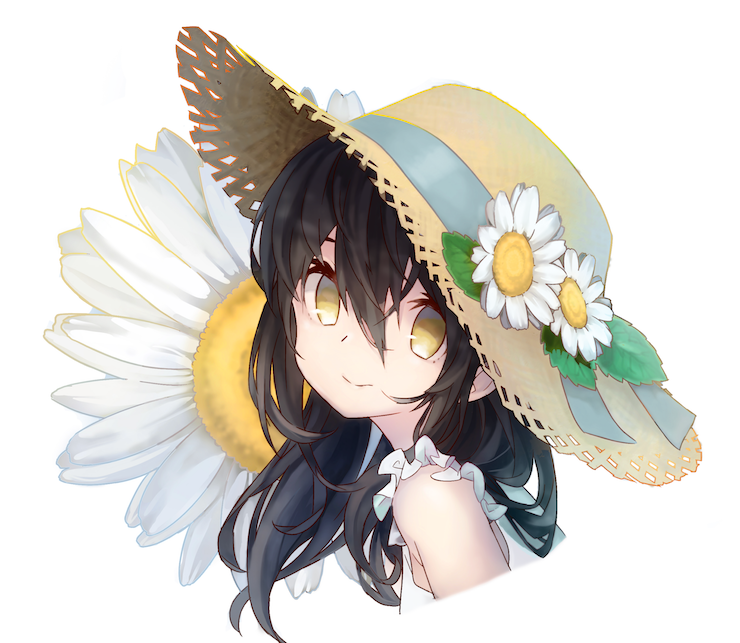
▲ 黒い線画に色をのせてみると、透明感がある美少女らしさが引き立ちました。
花びらの線画には青・黄色で柔らかく溶け込んだ印象に、そして麦わら帽子の線画には赤が入ることで夏の強い日差しを受けたような印象になりました。
アドバイスを受けていざ、塗りに再度チャレンジ!
それぞれの作品についての総評とアドバイスがさいとうさんと石井さんから行われ、講義は実技へと移ります。
先生ふたりが疑問・質問にはその場で答えてくれるものの、用意された時間はわずか90分(!)。限られた時間の中でアドバイスを反映すべく、3人は集中して作品と向き合います。
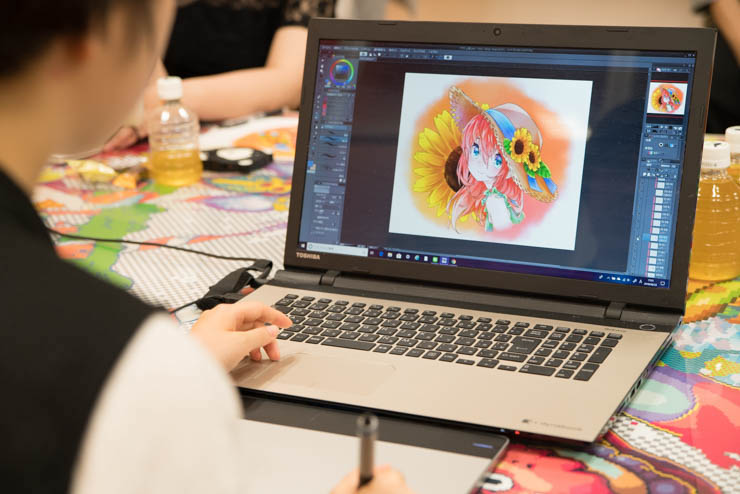
その過程でも、イラストに使えるテクニックが飛び出します。
全体像は常に表示!
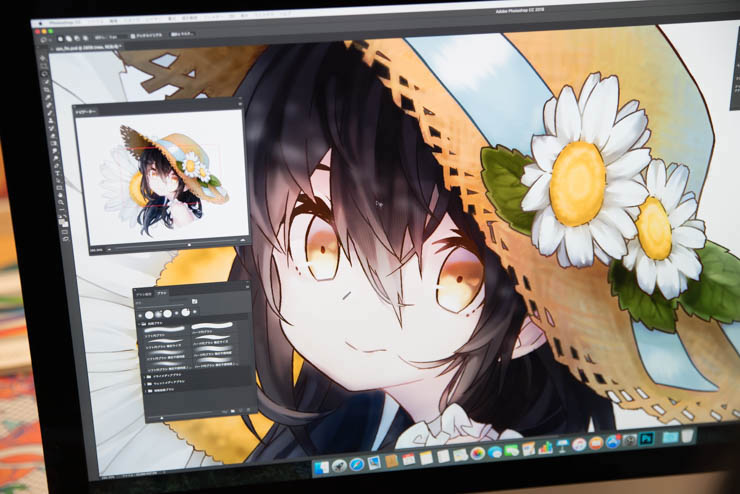
絵を描く際には、ぜひ全体像を表示しながら描いてみてください。必ず、仕上がりが変わります。アナログだと絵から離れないと全体像はみえませんが、デジタルだと絵から離れなくても全体像を把握できるので便利です!
迷ったときは白黒に変換してみる
明度差がしっかり出ているかをチェックするには、一度白黒に変換してみるのが手っ取り早く効果的です。白黒にしてぼやっとしているイラストは、カラーでもボヤっとしたつまらない印象になっている場合が多く、逆に白黒でも印象が変わらないのは、よい絵である場合が多いです。
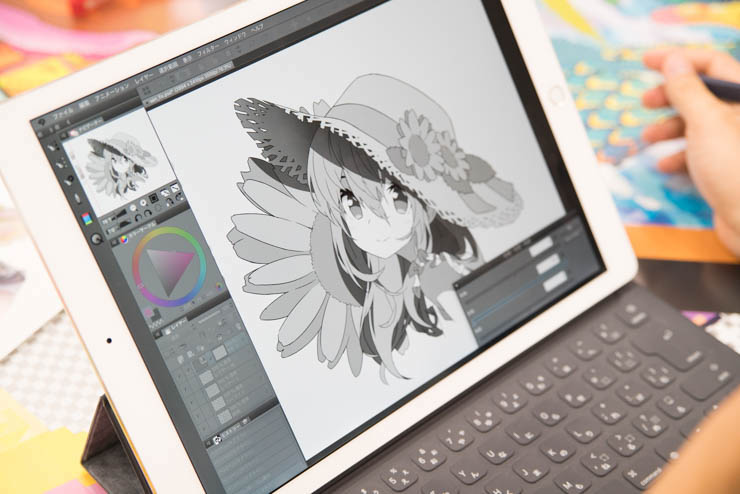
縁取りをしてみる
全体の形をハッキリさせるために周囲を縁取るというのは定番であり効果的な技法です。塊として目に飛び込んでくるので、見る人の視線が泳ぎにくいんですね。
線画の色を薄くしつつ一番外側のアウトラインだけ黒くすると、ふわっとしつつもシャキッとした印象を見る人に与えることができます。髪の毛の外側だけ色を変えてみる、洋服のパーツごとで線の色を調整してみるなど応用が利くテクニックなので、いろいろ試してみてください。

▲ 花びらの線画を黒でなくオレンジ系統の色にしている様子。イラストが色と馴染んだ感じがしますね。
こうして90分の実技時間はあっという間に終了。もらったアドバイスを元に、それぞれに試行錯誤して向き合った作品は、果たしてどのように生まれ変わったのでしょうか!?
果たして仕上がりは!? ビフォー&アフター発表会
森田さんのイラスト
森田:
リボンの赤に視線がいくと指摘いただいたので色を変え、赤は目のハイライトに差し色として入れてみました。

さいとう:
リボンのストライプが入るだけで、とたんに女の子っぽくなっていいですね! 全体的に明暗に手が入って、バランスがさらに良くなったと思います。ただ、瞳の赤は認識しづらいのでもう少し大きい方がいいですね。また細かい部分ですし、縮小した画像ではなかなかわからない所ですが、線の色を完全な黒じゃなくした事で、女の子の柔らかい印象が増しています。
石井:
肌の色が明るくなり太陽光線が強くなった、夏の日差しを感じさせる作品になりました。さいとうさんの言う通り、瞳の赤はいまの倍くらいあっていいでしょう。
四片さんのイラスト
四片:
最初は全体的にオレンジだったので、今回は思い切って背景を青に変えてみました。青空の反射も細かいとこに入れてみたのですが、どうでしょうか。

さいとう:
ヒマワリに入っている青がいいですね。この色を入れられるのは素直にすごいと思います。思い切った色の変更には勇気が必要で、こだわりがあればあるほど変えるのは難しいものなんです。
ひまわりの種部分の明度を上げた事でキャラクターの顔に目がいくようになっているし、3つそれぞれに明暗差をつけた事で画面にリズムがうまれています!
石井:
夏には汗ダラダラの暑い赤系統と涼しげな青系統、2つのイメージがありますが、この作品は最初のイメージと正反対へ一気に変えてきた。意志が強く自分で変えられる強さがあるから、中途半端な作品になっていません。これはすごいことですよ。
原田さんのイラスト
原田:
明暗差について教えていただいたので、コントラストを全部付け直し、清楚感というキーワードに合っていない色を変えてみました。

さいとう:
地力があるから一気にレベルの違う作品になった。うれしいを通り越して少し悔しいくらい(笑)。そのくらい違います!
ひとつ決定的に違うのは「いい香り」がしてきそうな絵になったという事。影色が黒だと少し清潔感が損なわれてしまうのですが、影色に色味を加える事で清潔感がグッと増します。だから観た瞬間「いい匂い」がしそう!という感覚につながったんです。クンカクンカしたくなりますね!
石井:
短い時間の中でよくぞここまで、というのが正直な感想。メリハリの調整と色の塗り足しにより、肩の関節が出てきてドレスの柔らかさが増しました。さらに白は少し色が足され、より白さが際立っている。アドバイスを的確に捉えていただけたようで、とてもうれしいです。
講師おふたりの作品も披露!
3人の総評も終わり、最後は講師陣の作品が披露されました。とはいえ、これが正解という訳ではなく、あくまで「おふたりが描いたらこうなる」という一例。正解は描き手の数だけあるのです。
石井先生の作品はこちら!
石井:
みんな女の子から描きはじめるだろうと思ったので、あえて花から塗りはじめ「花の色を引き立てるためにはどうしたらよいのか?」を考えて複数のパターンを作ってみました。
どの絵も大体8色から9色ぐらい使っています。色の持つイメージで作品の方向性が自然と決まっていくのが分かっていただけると思います。
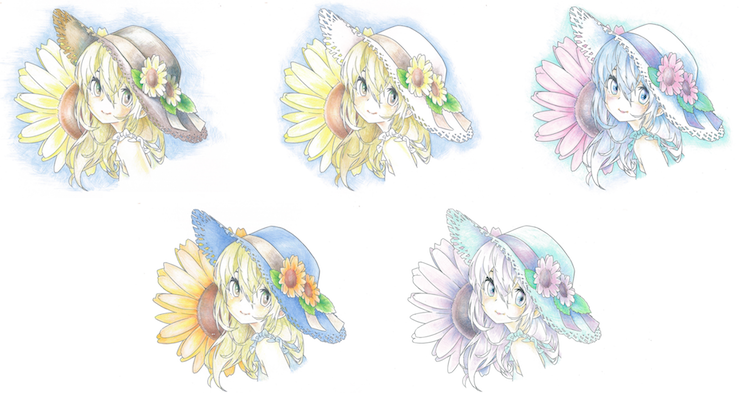
続いて、さいとう先生の作品はこちら!
さいとう:
線画は清楚な女の子をイメージして描いたつもりだったんだけど、みんなと被らないようにあえて元気系にしてみました。

さいとう:
黄色とオレンジを活かすために変化球だけど花を空に見立てて補色の青を入れ、瞳にはアクセントカラーを用いています。
また、素材感を出すために帽子には明度を抑えた状態で質感を入れています。ほぼ見えませんが、引いてみると麦わら帽子だと分かります。しっかり描かなくても描いているように見えるので、明度の調整はとても大切です。
講義を終えて
石井:
やはり絵を描くというのは観察力が必要です。デフォルメされた世界だからこそ、ちょっとした現実を入れないと、作品が軽くなってしまいます。抜くところは抜き、入れるところは入れる。舞台では、縫い物の芝居で本当に縫うとウソっぽく見えてしまうといいます。大きな所作が必要なんですね。
これはイラストでも同じこと。色もデッサンも考え方は同じです、がんばってください。
さいとう:
今回の講座で割り当てられた修正時間ってたった90分なんですよね。90分ってじっとしているとかなり長いですが、描いていると一瞬なんです。その一瞬でここまで上げてきたか、と。若い力ってすごい。教えているつもりですが、僕の方がパワーをもらいました。来てよかったと本当に思います。ちょっとでもお役に立てたのなら、とてもうれしいです。
いかがでしたか?
どの作品もわずかな時間で手を入れたとは思えない変容に、驚かれた人も多いのではないでしょうか。表現したいものが明確となり、作者の想いがより強く画面から伝わってくるように感じられるのは、正に色の持つ力。色ってすごい!
色のすごさを実感したら、色彩検定にチャレンジ!
色についてもっと知りたい、学びたいという人は、ぜひ色彩検定協会のサイトを訪れてみてください。色の持つ力の理由、学ぶための方法など情報が満載です。
そして、2018年11月11日(日)に実施される2018年度冬期検定はただいま申込み受付中! 申込みはインターネットから可能で試験会場は全国約400カ所。イラストにも必ず役立つ知識を自分の物にするまたとない機会をまずは11月を目標に、ぜひ挑戦してみてはいかがでしょうか。
申込み期間
8月1日(水)~10月4日(木)
インターネット申込み延長期間:10月5日(金)~10月11日(木)
試験日
【3級・2級・1級】11月11日(日)
【1級2次・ UC級 】12月16日(日)
試験時間
【3級】10:30~11:40(70分)
【2級】13:00~14:20(80分)
【1級】15:10~16:40(90分)
【1級2次】12:00~13:30(90分)
【 UC級 】15:00~16:00(60分)


※明度、色相、彩度とは
・明度
色の明るさのこと。「赤」の明度を高くすると「ピンク」に、低くすると「赤茶色」になります。
・色相
赤み、青み、緑みなど、「色みの性質」のこと。「色あい」ともいいます。例えば「赤」と「ピンク」は色相が「赤」になります。
・彩度
「色の鮮やかさ」のこと。純色(赤なら、最も赤らしい赤。最も彩度が高い)に同じ明度の灰色を混ぜていくと、同じ明度ですが、赤みが少なく感じられるようになります。いわゆる「くすんだ色」になります。灰色の割合が多くなり、赤の割合が少なくなると彩度が低くなります。彩度がない色が「無彩色」になります。